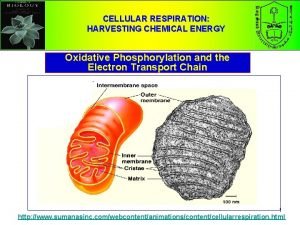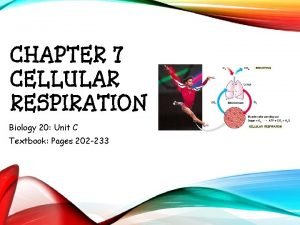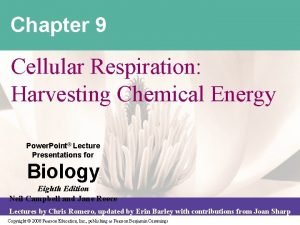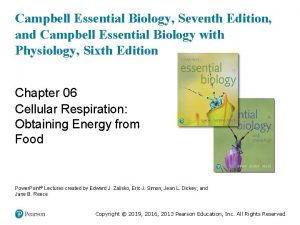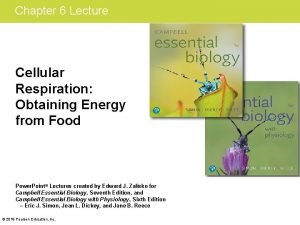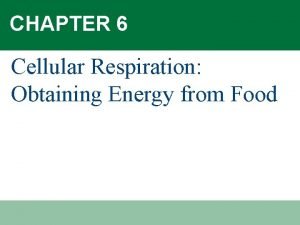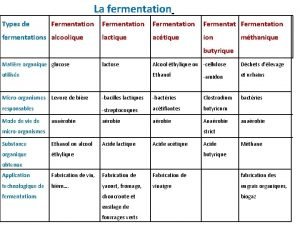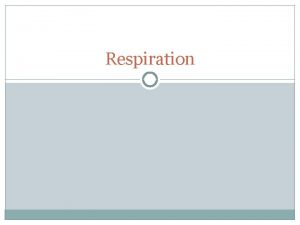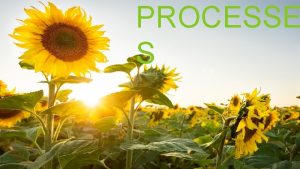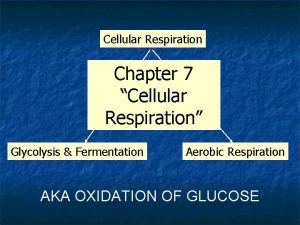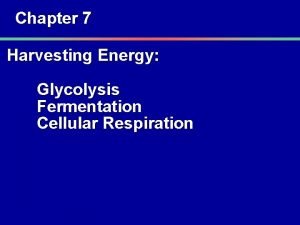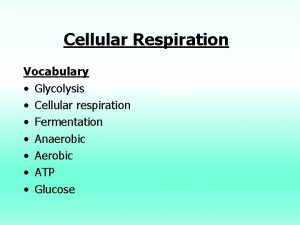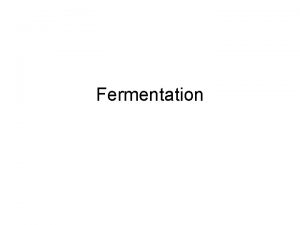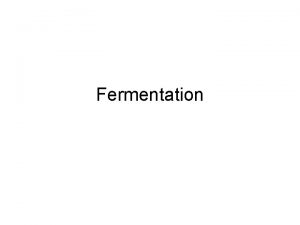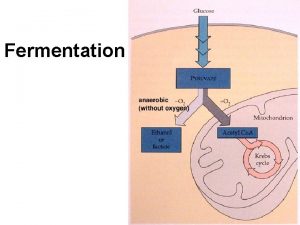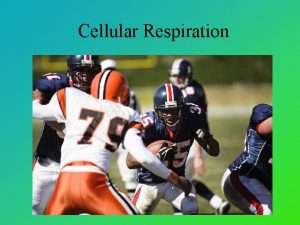Chapter 9 Harvesting Energy Glycolysis Fermentation Cellular Respiration


















- Slides: 18

Chapter 9 Harvesting Energy: Glycolysis Fermentation Cellular Respiration

Introduction and Vocabulary: Metabolism: Cells can metabolize a variety of organic compounds, but we will concentrate on the metabolism of glucose because it is the most common form of metabolism NAD+: Coenzyme used in reactons, can accept electrons and becomes NADH Aerobic: with oxygen Anaerobic: without oxygen

Different Stages of Glucose Metabolism: 1. Glycolysis • • • Does not require oxygen Occurs in Cytoplasm of the cell Produces pyruvate, 2 ATP, and 2 NADH

Different Stages of Glucose Metabolism: 2. Fermentation • Without oxygen • Anaerobic • Pyruvate is converted into lactate or ethanol • No ATP Produced • Occurs in cytoplasm of cells

Different Stages of Glucose Metabolism: 3. Cellular Respiration: Includes glycolysis, Krebs cycle, and electron transport chain • • Presence of oxygen Aerobic Pyruvate converted into CO 2 and H 2 O, and 36 to 38 ATP are produced Occurs in the mitochondria of cells

How is The Energy of Glucose Captured During Glycolysis? Glycolysis: means to “break apart” • • Glucose is broken down with or without oxygen in the cytoplasm into pyruvate One Glucose is cleaved into two pyruvate Produces little energy Two ATP and Two NADH produced

Glycolysis Has Two Steps: a). Glucose Activation b). Energy Harvesting Stage

a). Glucose Activation: • • Before glucose is broken down, it is activated. This takes energy (2 ATP) This reaction cost 2 ATP molecules

b). Energy Harvesting Steps: • • 1 Glucose splits into 2 G 3 P (3 carbon molecule) G 3 P molecule converts to 2 pyruvate 2 ATP are generated for each G 3 P to total 4 ATP, but you only get 2 ATP since you used 2 ATP to activate glucose 2 NADH produced, NADH is an electron carrier, NAD+ is an electron acceptor

Note: if oxygen is available, cellular respiration will occur in the mitochondria of the cell, but there is no available oxygen, fermentation will take place in the cytoplasm. Absence of oxygen • Production of ethanol or lactate • This is called fermentation • No ATP produced • Occurs in cytoplasm

Two Types of Fermentation a). Conversion of pyruvate into lactate (lactic acid) b). Conversion of pyruvate into Co 2 + Ethanol

a). Fermentation to Lactate: (Muscles) • • • Occurs in cytoplasm of muscles after vigorous exercise, sprinting fast, anaerobic activity Build up of Lactic acid Not enough oxygen to lungs, blood, and muscles to allow for cellular respiration Glycolysis does not stop Without oxygen, muscle cells ferment pyruvate to lactate or lactic acid If you stop the anaerobic exercise or slow down, and as you breath, oxygen becomes available.

Fermentation Continued: • • Lactate converts back to pyruvate, this happens in the liver Pyruvate then in presence of oxygen can be broken down into CO 2 + H 2 O by cellular respiration

2 ADP+ 2 Glycolysis 2 NAD Glucose 2 Pyruvic acid + 2 H 2 Lactic acid (a) Lactic acid fermentation Figure 6. 15 a

b). Fermentation to Alcohol ( microorganisms) • • • Many microorganisms use this process Anaerobic conditions Produces ethanol and CO 2 from pyruvate Yeast (microorganism), fermented fruits and grains into alcoholic beverages Champaign is bottled while the yeast are still alive so it traps both ethanol and CO 2 and gives the cork a pop when opened Bakers yeast produces CO 2, that is what makes the bread rise, the ethanol evaporates while cooking in the over



THE END OF HARVESTING ENERGY Part 1 Glycolysis and Fermentation
 Chapter 9 cellular respiration harvesting chemical energy
Chapter 9 cellular respiration harvesting chemical energy Chapter 9 cellular respiration harvesting chemical energy
Chapter 9 cellular respiration harvesting chemical energy Chapter 9: cellular respiration: harvesting chemical energy
Chapter 9: cellular respiration: harvesting chemical energy Electron transport chain summary
Electron transport chain summary Cellular respiration in the mitochondria
Cellular respiration in the mitochondria Cells produce atp most efficiently in the presence of *
Cells produce atp most efficiently in the presence of * Inputs of glycolysis
Inputs of glycolysis Energy flow in cellular respiration
Energy flow in cellular respiration Cellular respiration obtaining energy from food
Cellular respiration obtaining energy from food Cellular respiration obtaining energy from food
Cellular respiration obtaining energy from food Types de fermentation
Types de fermentation Chapter 8 section 3 cellular respiration
Chapter 8 section 3 cellular respiration Chapter 8 section 1 how organisms obtain energy answer key
Chapter 8 section 1 how organisms obtain energy answer key Redox reaction in cellular respiration
Redox reaction in cellular respiration The gray-brown haze often found over large cities is called
The gray-brown haze often found over large cities is called Chemiosmosis steps
Chemiosmosis steps Cellular respiration product
Cellular respiration product Fermentation reaction
Fermentation reaction Why is cellular respiration important
Why is cellular respiration important



